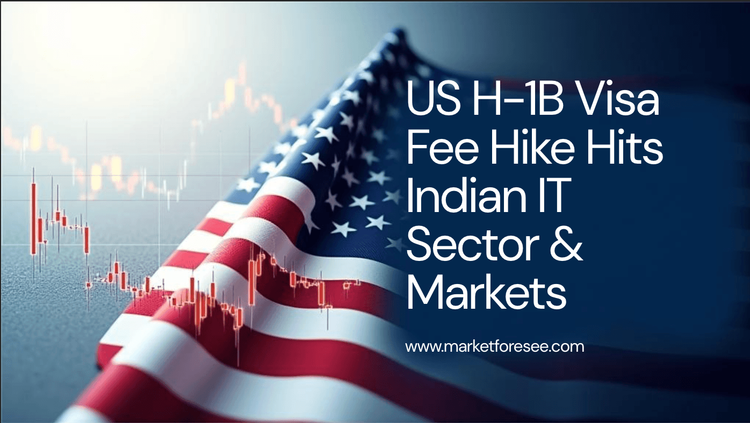U
Useruser@marketforesee.comDownload History
Change Password
⚠ Disclaimer: Trading involves risks. Do your own research before investing.🔔 Ad: Let Automation Do the Trading!Click here to learn more📢 Ad: Try Smart Assistance
⚠ Disclaimer: Trading involves risks. Do your own research before investing.🔔 Ad: Let Automation Do the Trading!Click here to learn more📢 Ad: Try Smart Assistance
⚠ Disclaimer: Trading involves risks. Do your own research before investing.🔔 Ad: Let Automation Do the Trading!Click here to learn more📢 Ad: Try Smart Assistance
US H-1B Visa Fee Hike Hits Indian IT Sector & Markets
9/23/2025

United States government under President Trump introduced a sweeping change to the H-1B visa regime, sharply increasing the one-time application fee to US$100,000 for new H-1B visa petitions. This policy move has sent ripples through the Indian IT sector and financial markets, provoking concern over increased costs, narrower margins, and potential shifts in how tech services are delivered globally.
What Changed ?
- The new rule imposes a $100,000 fee on new H-1B visa applications filed on behalf of foreign nationals outside the U.S. as of September 21, 2025.
- The fee does not apply to existing visa holders or applications submitted before the cut-off, according to clarifications from the White House.
- Also part of the changes are revisions in prevailing wage requirements and prioritization of high-paid, high-skill applicants in the H-1B lottery.
Why the US Did It ?
The stated rationale is multi-fold :
- To reduce abuse of the visa system, especially allegations that employers bring in H-1B workers at lower wages, sometimes displacing U.S. workers.
- To ensure H-1B recipients are paid wages more comparable to prevailing U.S. rates (i.e. increasing wage floors).
- To limit dependency on foreign skilled labor and encourage more domestic hiring.
Impacts on Indian IT Sector :
The Indian tech services and outsourcing industry, which has long relied on H-1B visas for deploying skilled workers to U.S. clients, faces several risks and challenges :
1. Margins Under Pressure
Companies are likely to see their cost of delivery increase significantly. Analysis suggests margin erosion of 50-150 basis points (0.50-1.50 %) for firms more exposed to H-1B usage.
2. Change in Workforce Strategy
With the new fee structure, many firms may prefer hiring local U.S. employees, subcontracting, or near/off-shoring work rather than deploying workers under H-1B visas.
3. Shift in Deal & Contract Economics
Larger service contracts, especially those involving on-site staff in the U.S., could be restructured to reflect higher visa cost burdens. Clients may push back or demand renegotiations.
4. Stock Market Reaction
Indian IT stocks saw immediate declines. The Nifty IT index dropped nearly 3%. Major players like Infosys, TCS, Wipro, Mphasis, LTIMindtree etc. were down significantly in early trading after the announcement.
5. Long-Term Structural Adjustments
The industry has already reduced dependence on H-1B visas over recent years, building up local hires in the U.S. and expanding offshore delivery models in India or other lower-cost locations. These changes may accelerate.
Risks & Uncertainties :
- The policy may face legal challenges, especially about whether the fee hike can be imposed without Congressional approval or without following standard rule-making procedures.
- Clarity is still needed on whether the $100,000 fee covers all petitions (initial, extensions, transfers) or only initial ones.
- There’s risk of client pushback: U.S. companies that rely on Indian IT firms for services may resist cost pass-through if the overall delivery costs inflate too much.
- Competitive risks: other countries (e.g. Canada, Singapore) might attract talent or contracts displaced by this policy.
Broader Market & Economic Effects :
- Investor Sentiment Weakened: Indian equity markets, especially the tech/IT indices, saw negative sentiment due to anticipated earnings pressure.
- Currency Pressure: The rupee slid to record lows, partly attributed to the expectation of reduced foreign inflows and lowered U.S. demand for Indian labor.
- Trade & Diplomacy Strain: The fee hike adds to existing tensions over trade and immigration policies between India and the U.S. India has officially objected and called for clarifications.
What Firms Can & Should Do ?
- Review and possibly renegotiate international contracts to include cost escalations or risk sharing.
- Increase hiring of local talent in the U.S. (onshore) to reduce dependence on visa-based deployment.
- Expand nearshore or offshore infrastructure for execution of work, thus lowering the portion of work requiring immigration or travel.
- Consider alternative visa categories or immigration pathways, and press for clear guidance on interpretation of the new rules.
- Improve efficiency and automation to reduce reliance on large numbers of deployed people.
While the fee hike is unquestionably a sharp shock, many analysts believe the Indian IT sector has enough flexibility to adapt. Over the last few years, firms have already been gradually reducing dependence on H-1B visa deployment, investing more in local staffing, and optimizing delivery models. The immediate impact will likely be felt in contract margins and short-term earnings estimates for FY26-27. However, long-term impacts will depend heavily on how strictly the rule is enforced, how clients accept cost increases, and if any legal or regulatory modifications occur.
- MarketForesee Research Desk
---------------------------------------------------------------------------------------------------------------------------
US H-1B visa fee hike | $100,000 H-1B visa fee | impact on Indian IT stocks | Indian tech sector challenges | US immigration policy change 2025 | margins pressure Indian IT | Nifty IT drop H-1B fee | outsourcing costs impact | reform in H-1B visa rules | Indian IT firms adaptation | US-India trade / visa relations | labor mobility and skilled immigration | prevailing wage H-1B fee | tech stocks decline news